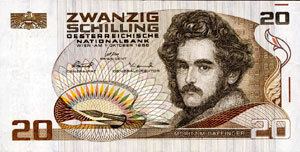20 Schilling note, issued in 1986. 20 Schilling coin. 1/100 Groschen Groschen Groschen | Code ATS Plural Schilling Symbol S or öS | |
 | ||
The Schilling (German: Österreichischer Schilling) was the currency of Austria from 1925 to 1938 and from 1945 to 1999, and the circulating currency until 2002. The euro was introduced at a fixed parity of €1 = 13.7603 Schilling to replace it. The Schilling was divided into 100 Groschen.
Contents
First Schilling
The Schilling was established by the Schilling Act (Schillingrechnungsgesetz) of December 20, 1924 at a rate of 1 Schilling to 10,000 Austro-Hungarian Kronen and issued on March 1, 1925. The Schilling was abolished in the wake of the Anschluss (1938), when it was exchanged at a rate of 2 German Reichsmark to 3 Schilling.
Second Schilling
The Schilling was reintroduced after World War II on November 30, 1945 by the Allied Military, who issued paper money (dated 1944) in denominations of 50 Groschen up to 100 Schilling. The exchange rate to the Reichsmark was 1:1, limited to 150 Schilling per person. The Nationalbank also began issuing Schilling notes in 1945 and the first coins were issued in 1946.
With a second "Schilling" law on November 21, 1947, new banknotes were introduced. The earlier notes could be exchanged for new notes at par for the first 150 Schilling and at a rate of 1 new Schilling for 3 old Schilling thereafter. Coins were not affected by this reform. The currency stabilised in the 1950s, with the Schilling being tied to the U.S. dollar at a rate of $1 = 26 Schilling. Following the breakdown of the Bretton Woods system in 1971, the Schilling was initially tied to a basket of currencies and then, in July 1976, the Schilling was coupled to the German mark.
Although the Euro became the official currency of Austria in 1999, euro coins and notes were not introduced until 2002. Old Schilling denominated coins and notes were phased out from circulation because of the introduction of the euro by 28 February of that year. Schilling banknotes and coins which were valid at the time of the introduction of the euro will remain exchangeable for euros at any branch of the Austrian National Bank (Österreichische Nationalbank) indefinitely.
First Schilling
In 1925, bronze 1 and 2 Groschen, cupro-nickel 10 groschen, and silver 1⁄2 and 1 Schilling coins were introduced, followed by cupro-nickel 5 Groschen issues in 1931. In 1934, cupro-nickel 50 Groschen and 1 Schilling were introduced, together with silver 5 Schilling. Coins were issued until 1938.
Second Schilling
Between 1947 and 1952, coins in denominations of 1, 2, 5, 10, 20, and 50 Groschen; and 1, 2, and 5 Schilling were introduced. The 2 and 50 Groschen; 1, 2, and 5 Schilling were struck in aluminium, as was the second type of 10 groschen coin. The 1 and 5 groschen and the first type of 10 groschen were in zinc, with the 20 groschen struck in aluminium-bronze. The 1 groschen was only struck in 1947, while the 20 groschen and 2 Schilling coins were suspended from production in 1954 and 1952, respectively. In 1957, silver 10 Schilling coins were introduced, followed in 1959 by aluminium-bronze 50 groschen and 1 Schilling, and in 1960 by silver 5 Schilling coins. Thus, the 5 Schilling coins went from an aluminium composition to a silver one, a highly unusual event made possible by the substantial improvement of the Austrian economy in the 1950s. Cupro-nickel replaced silver in the 5 and 10 Schilling coins in 1969 and 1974, respectively. An aluminium-bronze 20 Schilling coin was introduced in 1980.
Silver coins were in the value of 25, 50, 100, 200 and 500 Schilling, but gold coins also existed for 500 and 1,000 Schilling. They were considered legal currency, but were rarely found in actual transactions.
At the time of the changeover to the euro, the coins in circulation were the following. Coins under 10 groschen were rarely seen in circulation during their final years.
- 10 Schilling has pure nickel core
- Smoothly with 19 pits until 1992. In 1993, all previous 20 Schilling coins were reissued with smooth edges.
